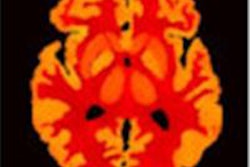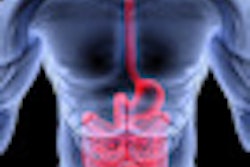
Researchers from Nottingham, U.K., have found that PET/CT may be better than endoscopic ultrasound (EUS) for accurately estimating tumor length in cases of esophageal cancer. PET/CT's enhanced performance in turn might lead to better planning of radiotherapy and resection.
The findings, published in the February issue of the European Journal of Radiology, concluded that PET/CT images correlated "most strongly" with histopathological results and outperformed the limitations of endoscopic ultrasound (EUS) and esophago-gastroduodenoscopy (OGD) (February 2015, Vol. 84:2, pp. 195-200).
Researchers, led by Dr. Katie Rollins in the department of esophago-gastric surgery at the Nottingham (U.K.) University Hospitals, suggested that PET/CT's performance could be a benefit in the planning of patients' radiotherapy, resection, or other treatment options.
Rollins and colleagues noted that radiotherapy has become a more widely used method for both curative and palliative treatment of malignant esophageal cancer. "Accurate treatment depends on determining tumor location and length," they wrote.
Accepted methods
Endoscopic ultrasound is generally considered the best method for measuring tumor length and assessing the local stage of various cancers, but some previous studies also have promoted PET/CT's ability to measure tumor length and correlate well with EUS findings (European Radiology, July 24, 2008; Vol. 18:12, pp. 2833-2840).
However, other literature has questioned the efficacy of endoscopic ultrasound in assessing obstructive tumors. On the other hand, PET/CT was found to be highly accurate when a maximum standardized uptake value of 2.5 was used prior to surgery to estimate tumor volume and length (European Journal of Nuclear Medicine and Molecular Imaging, April 2011, Vol. 38:4, pp. 656-662).
Until now, Rollins and colleagues added, "[t]he value of PET/CT over EUS in the estimation of tumor length is not clear."
This retrospective study enrolled 53 patients with a median age of 64 (ranging between 44 and 79 years old) at the time of the primary diagnosis. There were 45 male and 19 female patients in the cohort. All subjects were diagnosed and evaluated for biopsy-proven cancer of the esophagus gastroesophageal junction (GOJ) between September 2012 and October 2013.
All patients also received a PET/CT scan, endoscopic ultrasound, and esophagogastroduodenoscopy (OGD) as part of their preoperative staging process to determine if they needed surgery or neoadjuvant therapy.
Histopathology samples also were obtained from all study participants and were assessed by one of 12 histopathologists in the same department.
"The reported length of residual tumor was a macroscopic measurement detailed as part of the standard histopathological reporting pro forma for esophageal carcinoma," the authors noted.
PET/CT vs. EUS
In comparing the modalities, researchers found a strong positive and statistically significant correlation between PET/CT estimates of tumor length and histopathological results (r = 0.5977). Estimates of tumor length on endoscopic ultrasound also correlated positively with histopathology (r = 0.5365), but less significantly than PET/CT. OGD's assessment of tumor length compared with histopathology was far less impressive (r = 0.1574) and results were deemed not significant.
Researchers also compared the modalities' estimates of tumor length with histopathological results in 34 patients who did not respond favorably to neoadjuvant chemotherapy. The additional analysis was performed in order to eliminate any potential bias if tumor size and length decreased because of therapy.
In this category, PET/CT tumor length (r = 0.5651) again achieved a strong positive correlation with histopathology results, although not as great as with the entire patient cohort. Meanwhile, endoscopic ultrasound again correlated well (r = 0.4637) with histopathology, but fell short of PET/CT's prowess. OGD's evaluation of tumor length (r = -0.1084) was far short of histopathology, PET/CT, and EUS.
PET/CT's benefits
Rollins and colleagues concluded that PET/CT's estimated tumor length correlated "most highly" with histopathology, which is considered the gold standard measure of tumor length, with endoscopic ultrasound as the next-most predictive measure of tumor length and OGD as a "poor measure."
They added that while PET/CT represents an "excellent adjunct" to the staging process of tumor length estimation, the hybrid modality also "avoids the risk of perforation related to instrumentation of the esophagus, again an unavoidable risk related of [endoscopic ultrasound,] which can have catastrophic consequences."


















